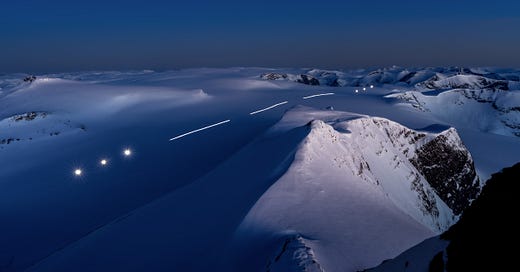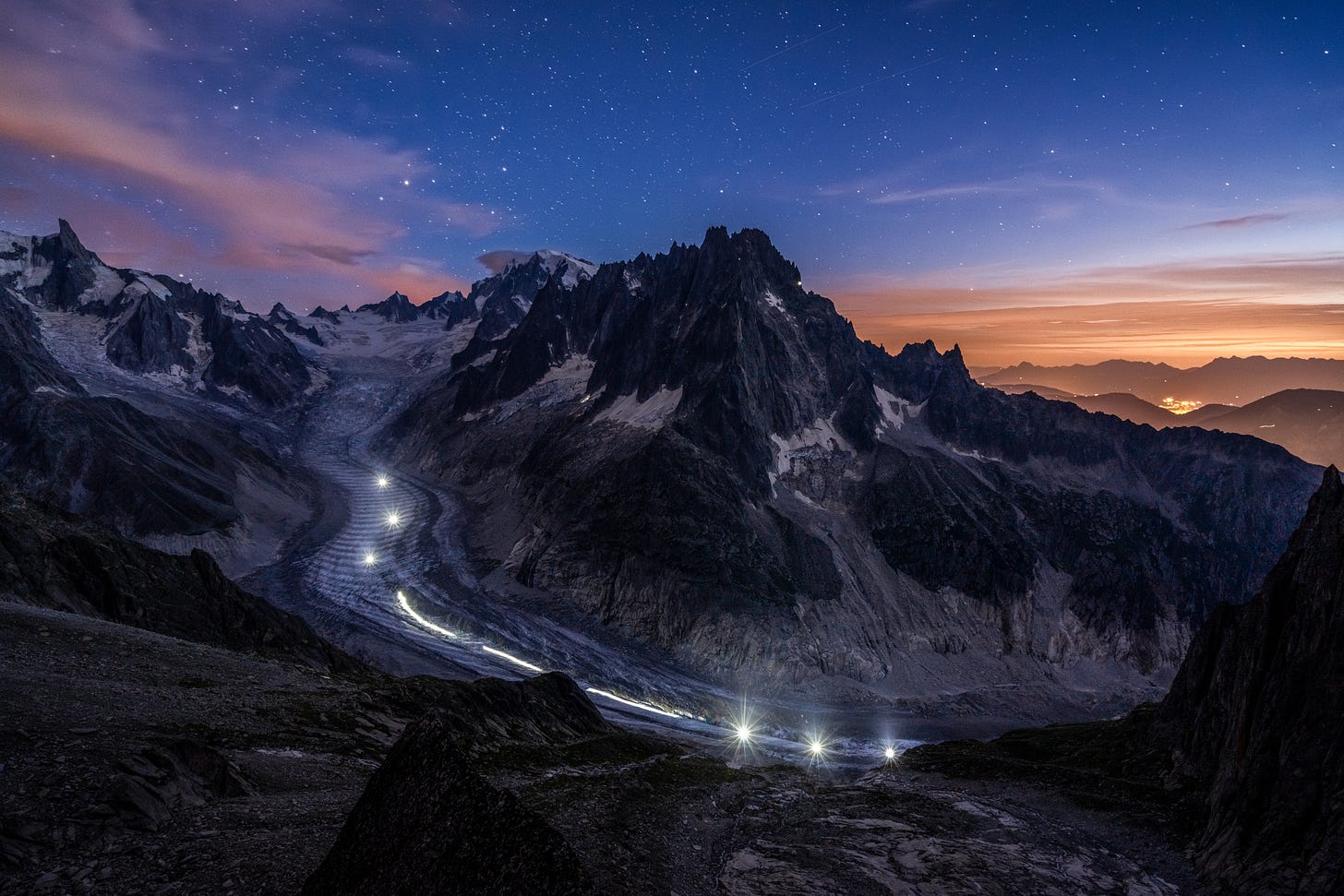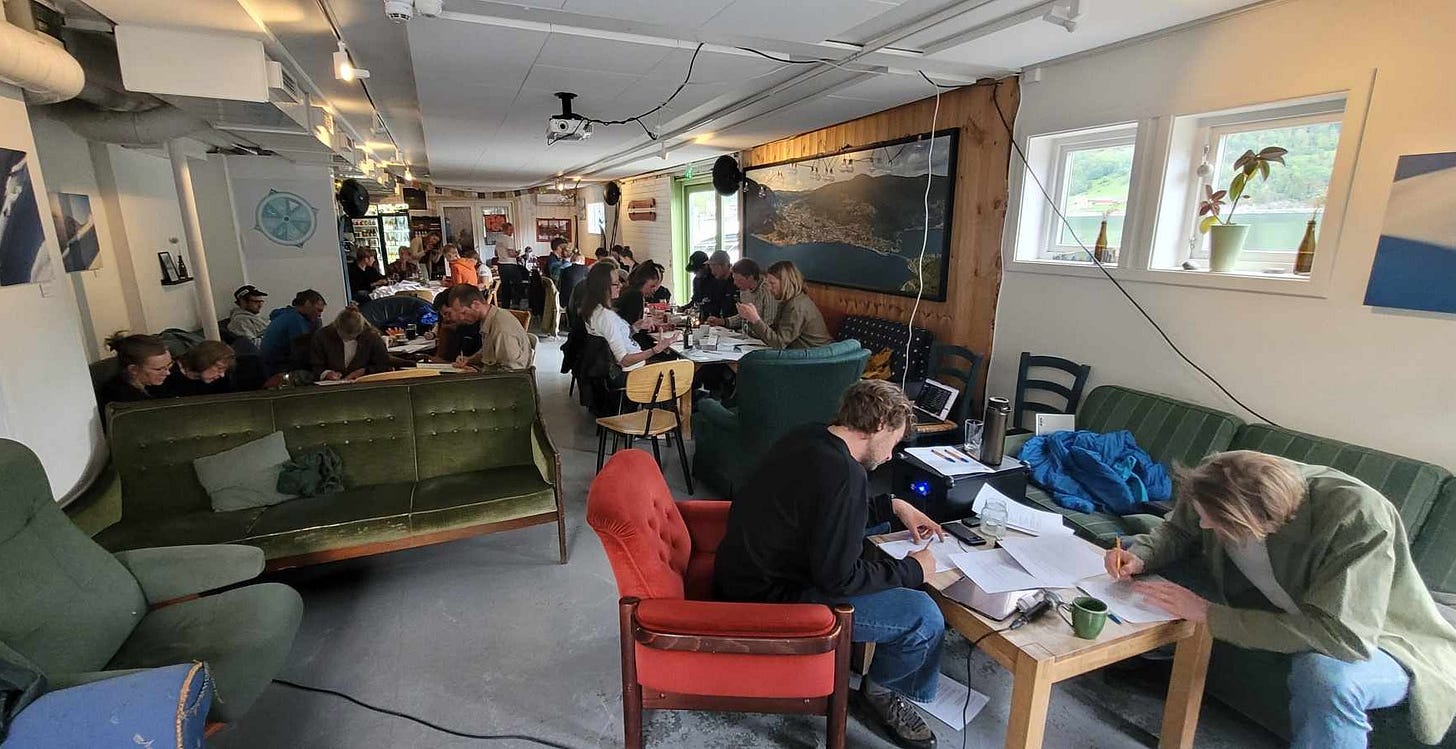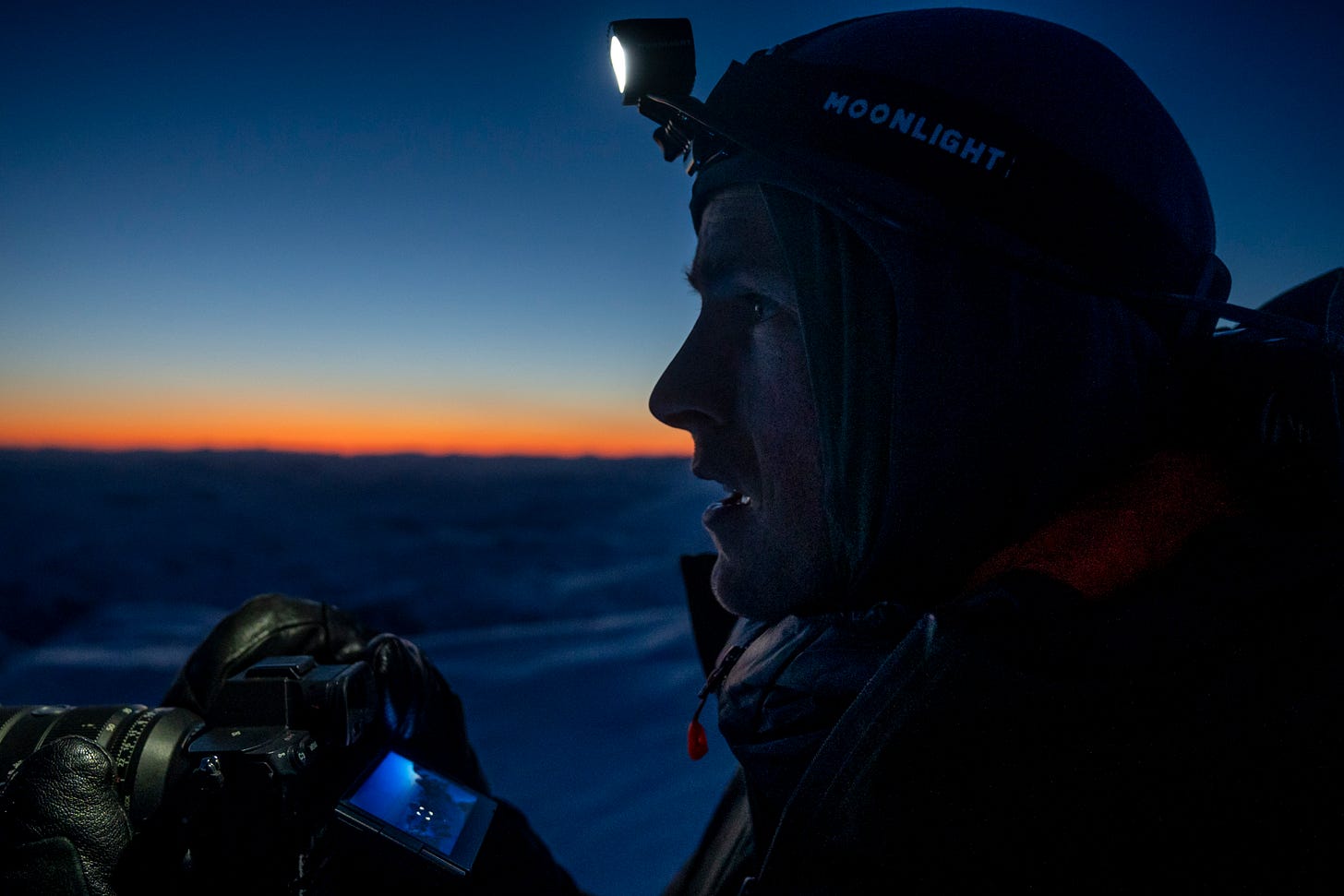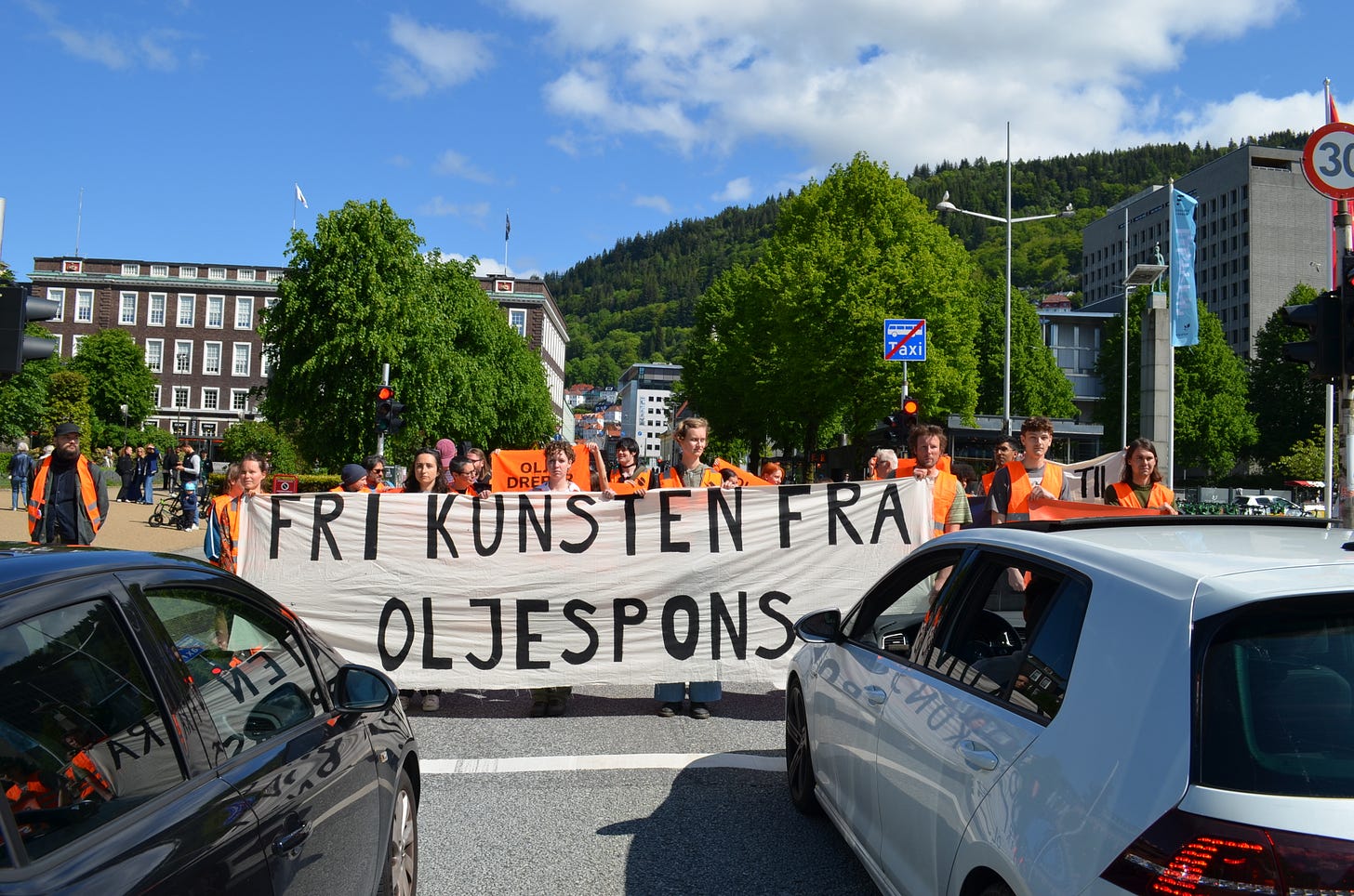An SOS Signal From The Biggest Glacier In Mainland Europe
Five things I have learnt through developing the SOS Project with my friend Vegard Aasen.

Last week we launched the second photo in the SOS Project. A three part photo series where we try to send an SOS signal from three different iconic landscapes that are under threat. The first photo, launched in December, was shot on the Mer De Glace in Chamonix. This second photo was shot in our backyard here in Western Norway.
This second photo is a protest against mass tourism and the destruction of wild nature for profit. There are plans to build a gondola right up to the edge of the glacier - the biggest glacier in mainland Europe, protected by a national park. It is a crazy plan which is solely to cater for mass tourism and the increasing number of cruise ships that sail up the fjords. The developers want to deliver 75 000 people a year up into one of the most inhospitable places in Norway. Gondola’s are being built all over the country as more and more tourists flock here to experience the wild nature. However, the nature they come here to experience is slowly being eroded away, bit by bit.
Watch Vegards video about the project below:
The reason I moved to this part of Norway was precisely because of the wild nature. I love being able to wake up in the morning, drive 20 minutes, put my skins on my splitboard and go up some random valley and not see another track all day. It is something completely different to the Alps where you have infrastructure everywhere. And yes, I know this may sound very privileged and like I just want to “keep the mountains for myself”. However I do think there is something deeply important about humans being able to experience wild nature.
I know for me personally that being in these wild landscapes make me feel alive. It makes me feel small. It makes me feel like I want to do all I can to protect these places. To stop the destruction we humans are inflicting on nature and to the climate.
The idea for the SOS Project came about a few years ago while talking to Moonlight Mountain Gear. The CEO was sitting in the Alps at 2000m and it was 40 degrees. He basically asked us if we wanted to do something using their lamps which would engage people in climate action. We suggested this slightly harebrained idea to create massive SOS Signals onto iconic landscapes like the Mer De Glace and Jostedalsbreen. To be honest we didn’t really know if it would even work until we were standing on the Mer De Glace in the middle of the night about to take the first photo.
The photos are taken using a very long exposure and at least 9 different people with a headlamp on the glacier below. The three dots sit still while the dashes of the SOS Signal run or ski to create the dash of light. This all has to be done at the same time and in quite a short window of time in the middle of the night. We have definitely had some stressful moments trying to pull it off! On the glacier here in Norway we had over 20 people joining to make it happen.
A Behind The Scenes Reflection
What I wanted to write about here was more of a behind the scenes reflection on this kind of activism. This second photo has been different to the ones that Vegard and I have done before because for this one we have (alongside two other friends) launched a campaign to go alongside it: www.reddjostedalsbreen.no.
We have developed a contact database, an email system and a plan for escalating engagement to really increase the pressure on the authorities to kick the gondola project into touch - where it belongs.
I have been a bit frustrated at some of the previous photo projects we have done together because it always felt a bit like social media activism. People would share the video or photo on Instagram for a few days, it would get hundreds of thousands of views but other than that I didn’t really feel that it was achieving any kind of concrete change.
As many of you who read this will understand by now, I am not really into these kinds of campaigns. I think if you are engaging people you should always have a very concrete call to action. You should have a plan for political engagement. You should have a clear demand.
It has been one of my big criticisms of so much of the activism in the outdoor industry to be honest. I feel like there is a lot of social media activism that makes you look like you are “engaged”. But does it really do all that much to change anything? So this project is a way to test whether we can actually build something more out of a viral video on instagram. And I think we have found some quite interesting results!
Read on for the five things I have learnt through helping to develop the SOS Project with Vegard.
1. In Norway, Nature Protection Is Not Worth The Paper It Is Written On
Vegard and I started these kinds of photo projects a few years ago with Light Lines. That was where we drew lines of light down 10 iconic Norwegian mountains to highlight how quickly we can change wild nature - in the blink of an eye. The main message of the project was that the time it takes us to ride down these mountains and change the landscape, is the same amount of time it takes for politicians to make a decision to approve building out into wild nature.
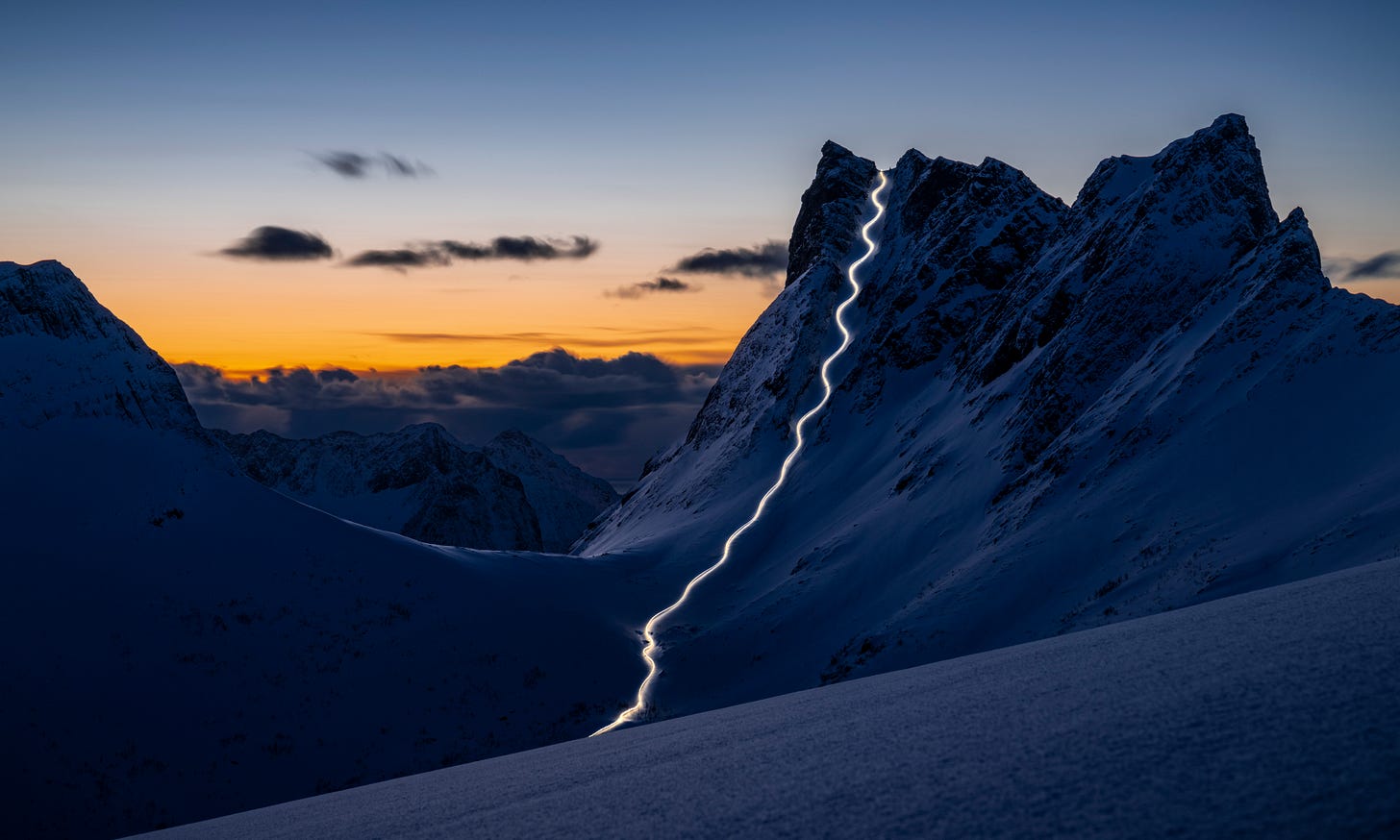
At the start of that project we actually joked about people building ski lifts up to these famous mountains protected by national parks. It is really no joke anymore. If this gondola up to Jostedalsbreen is built - it makes a total and utter mockery of the nature protection laws in Norway. The proposed gondola will go right up to within 20 metres of the national park boundary.
In some ways - these laws have already been made a mockery of. In June 2023 the government de-protected a nature reserve (the strictest form of protection) in order to build a new 4 lane motorway through a part of the reserve. This was one of the main things we wanted to communicate in the Light Lines project - that if they can simply de-protect a nature reserve - then no where is safe. Not even our iconic national parks. What we are now seeing with these gondola plans is just an extension of that.
2. People Like Activism That Is “Safe”
One of the biggest learnings for me over the last year after launching these photos is the difference in response when something feels safe and you can relate to it. I have been quite blown away by how viral these first two photos have gone. Every single time we launch one of these it feels like my entire Instagram feed for one day is just filled with people sharing it on their stories. One of the reasons is that Vegard is an incredible storyteller and he makes very good videos. However, another part of it, I think, is that this is a way for people to engage themselves that feels relatively safe.
I think a lot of people these days feel that things in the world are going in a very bad direction - the destruction of nature, the escalation of the climate crisis and the rise of right wing movements. However, the problem is that so many people feel paralysed and are not sure how to engage themselves.
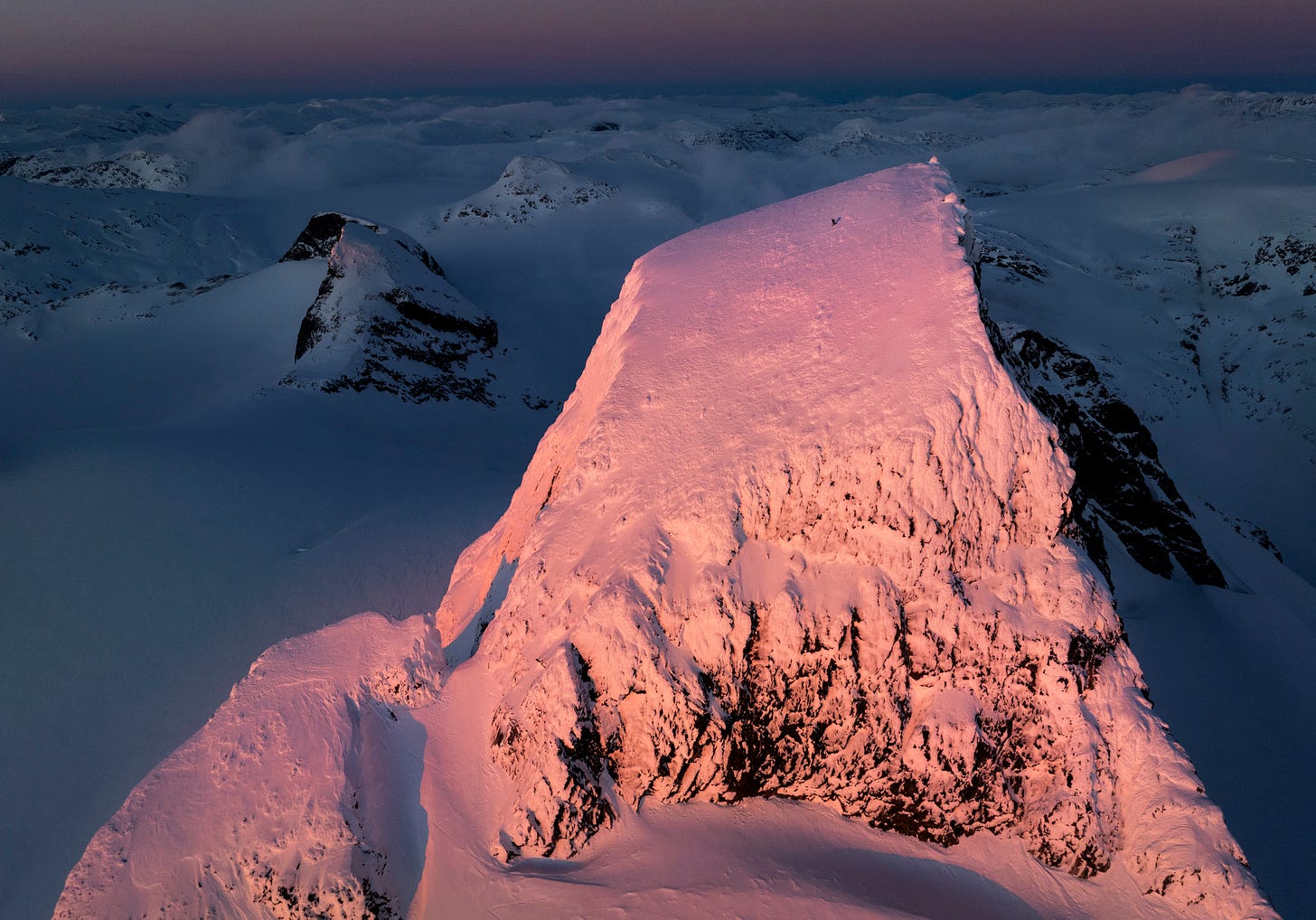
I have thought for many years about how we can better engage people in climate action. Often the problem is that it just seems so vague. It is so far off in the future. It is a strange elusive concept which is hard to relate to the present day. The fossil fuel industry have also done an amazing job of making it difficult to know who is responsible.
However, these gondola plans are very easy to grasp. You see a wild glacier that has little human impact. You picture a gondola transporting 75 000 people up there every single year. It is pretty obvious that this is something that is going to have an enormous impact.
I do believe though that there is more to it than this. I think some of it comes down to our identity and our longing to engage in activism which we can identify with on a personal level. I think the fossil fuel funded right wing media over the last few years has done an amazing job at making climate activists out to be either jobless, crazy or just young people without any idea how the “real world” works. This is a very effective way of making many people in society feel like they cannot identify themselves as a “climate activist”.
Compare this to how the SOS Project is communicated. It is mountains and glaciers and people on skis. It is very easy for outdoorsy people to immediately feel like they can associate with it and feel its part of their identity. They find it easy to share onwards without critique or comment.
I found this quite fascinating with the first SOS photo that we published. The call to action was for people to endorse the Fossil Fuel Non Proliferation Treaty. The messaging was that these glaciers are massively threatened by climate change and that it is the fossil fuel industry that is responsible and the ones that need to be regulated. It is the exact same demand that we were trying to communicate with the airport actions that I wrote about last week. The ones which people in the UK are still sitting in prison for.
How many of my own friends shared the Instagram post about the airport actions? A couple maybe. How many shared the SOS Photo from the Mer De Glace calling for the exact same thing? A lot - basically my entire instagram feed was filled with that video for one day.
I think this just comes down to that it is safe for them to share the SOS Photo but by sharing a video of 3 people breaking through the security fence at an airport and glueing themselves to the tarmac they are putting themselves out there. They are breaking a norm and they may face some critique for it. It is not totally “safe”.
3. Data Collection Is Crucial
One of the main things that I have been frustrated at with social media activism is that it often feels like the energy and momentum a viral post generates disappears quickly into the void. One thing that we focused on with this second SOS photo is to have a well functioning contact database and email system ready for people to sign up to when it launched. This was so that we could provide people with a next step to engage themselves as soon as they had seen the video on Instagram.
I have been working with friends of mine at the start up Catalyst (https://catalystcrm.org) for a while through the other campaign I am involved with in Norway (www.folkmotfossilmakta.no). The idea that Catalyst has is that in order to grow these types of campaigns and engage more and more people in political action - we have to have very well organised systems to help us do this.
I think if you are working with political campaigns it is incredibly important to recognise how crucial data actually is. If you do not have a good way for people to leave you their contact details - what is the point in your campaign? It is never going to grow. You are never going to engage more people. They are never going to be able to do anything other than share it on Instagram.
The results of this in the launch of the SOS Jostedalsbreen photo have been quite interesting. Since the photo was released last week we have had 2500 hits on the website. Not an insane number by any means but of those 2500 people, 820 of them have signed up to our contact database. This means that we now have 820 people that we can email and further their engagement.
I think it's very important that we think along these lines - that you aim to create a wide funnel for lots of people to engage themselves in your campaign but then make sure you provide people with next steps as soon as possible. We have already got a protest in the calendar for the 19th of June which those 820 people can already sign up to. It is important that from that wide funnel you are already providing people clear pathways on the step to taking action. I think this is key for these types of campaigns. That at every single step people are always given a call to action so that they can actually do something themselves which then gives them a feeling of agency.
4. Political Engagement Needs To Happen In Meeting Rooms, Not On Instagram
Last Monday we held the first meeting for the campaign. Over 40 people showed up to our local pub and we all hand wrote objection letters to the gondola together which were then delivered to the local council. This for me is real political engagement. Sitting around a table with other people, talking about the issues and acting.
It has been interesting to see that the huge number of people who shared the video on Instagram did not then translate into a mass of objection letters being sent to the council. However when people meet up in a room together almost everyone spent the time to sit there and write out a letter. I think it is something about the act of coming together with other people and sitting around a table. It makes people feel heard and that they can actually do something.
I often find sharing things on social media gives me a feeling of emptiness and disempowerment. That I am just howling into the wind. When I come together with other people in a room I always leave with a positive feeling that change is really happening. People need to feel agency and empowerment and this comes from discussing respectfully with other people, feeling like their voice matters and taking concrete action.
5. The Importance Of Using Your Platform
The final thing I learnt through this project is about platforms and how we use them. I am lucky to have a friend, Vegard, that understands the importance of using his platform. Vegard could have just become a commercial photographer and made loads of money using his photos to sell products.
Instead he has decided to use his skills to tell a different story. To tell a story about the fragility of the nature we all enjoy, about the constant race for profit which is destroying this nature and about how we can all act to push politicians to change course. He understands the platform that he has to tell this story through his photography.
The problem is though - that not all of us can become amazing photographers in order to have a platform. What is the most impactful thing that the ordinary person can do? I think that is what we need to focus on. For me - this means civil disobedience. I dont have the same kind of platform as Vegard. For me - civil disobedience is a way to create a collective platform in society and to create a conversation which challenges powerful structures.
That was why I took the action at the airport last summer. Even though I knew the consequences could be very serious, I was certain that it would create a conversation in society about the Fossil Fuel Treaty. That is exactly what happened (as I explained in my article last week) - we were given the chance to speak on the evening news the day after.
I think what is most important is to make sure we are focusing on how we can make it as easy as possible for regular people to feel like they can do something. Whether that is attending a protest or sending in an objection letter it is about making it easy for people to step onto the ladder of engagement and take part in collective action.
Whether this is about the destruction of wild nature, the climate crisis or the advance of the far right. The most important thing we can do in 2025 is to act together.
Thanks for reading this weeks article. Let me know what you think in the comments or send me an email at calum.m.macintyre@gmail.com.
Next week I am going to write another behind the scenes reflection about a campaign for Folk Mot Fossilmakta I was just involved with in Bergen. It was Norway’s biggest cultural festival and it was sponsored by Equinor. I think this was another quite successful attempt to use these events (like we did at the World Ski Championships this winter) to turn the conversation to the climate crisis and the power of the fossil fuel industry.

